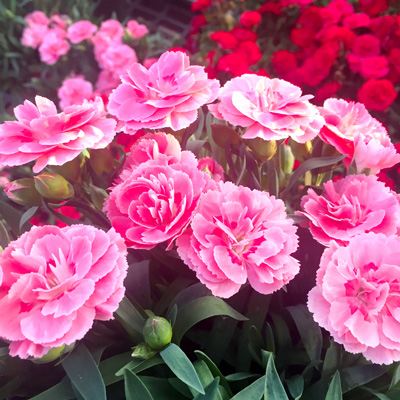Quick Spots of Color
Before I start my sales pitch on these two plants, a bit of my own history with them.
• I’ve always loved carnations (the greenhouse crop). So much so that I chose Colorado State University to begin my master’s degree program underwritten by Denver Wholesale Florists. That was the late 1960s, and almost all of the carnations in the United States were grown in Denver. I was going to get to work on growing and hybridizing them. But imported carnations soon took over the entire market. Carnations left Colorado and headed south. And I got engaged to my girlfriend back at Ohio State and headed east back to OSU. Some things are just more of a draw even than carnations! (Lynn and I have been married 55 years.)
• Cyclamen were hardly ever seen even in flower shops way back then. They were grown in very cool climates (55-60F) and heavy potting soils. It took many, many months to bring them into flower. Nope. Nope, and even more nope. I’d never encountered any of those in my tender young years in the business.
So, we jump ahead to today…
Plant breeders have been very busy in those ensuing decades. They’ve brought us scores of new types of dianthus (carnations, pinks and others out of this clan).
• Garden carnations, or double pinks (so-named because their petals look like they were trimmed with pinking shears) are delightful little winter/early spring annuals. They probably won’t make it through the heat of the summer (in spite of what the nursery tag may tell you), but they’ll certainly cheer up their surroundings well into the spring.

I referred to these as “double pinks.” You’re probably familiar with regular garden pinks. They’re some of our finest mid-winter annual flowers for planting directly into beds and large patio pots. They are second only to pansies in their winter hardiness. They bloom from now clear into mid-spring in shades of red, lavender, pink and white, many with colorful bandings. They have the same clove-like fragrance of florist carnations (their cousins).

• Cyclamen are popular potted plants for Christmas and Valentine’s Day, but smaller selections work well in patio pots and wall planters outdoors. They continue blooming for many weeks in shades of red, pink, lavender and white. They combine well with other plants to make stunning dish gardens.
Cyclamen must have cool temperatures. Gardeners are always tempted to nurse them through the summertime but trust me on this one – it’s far more rewarding simply to buy fresh plants late every fall.
